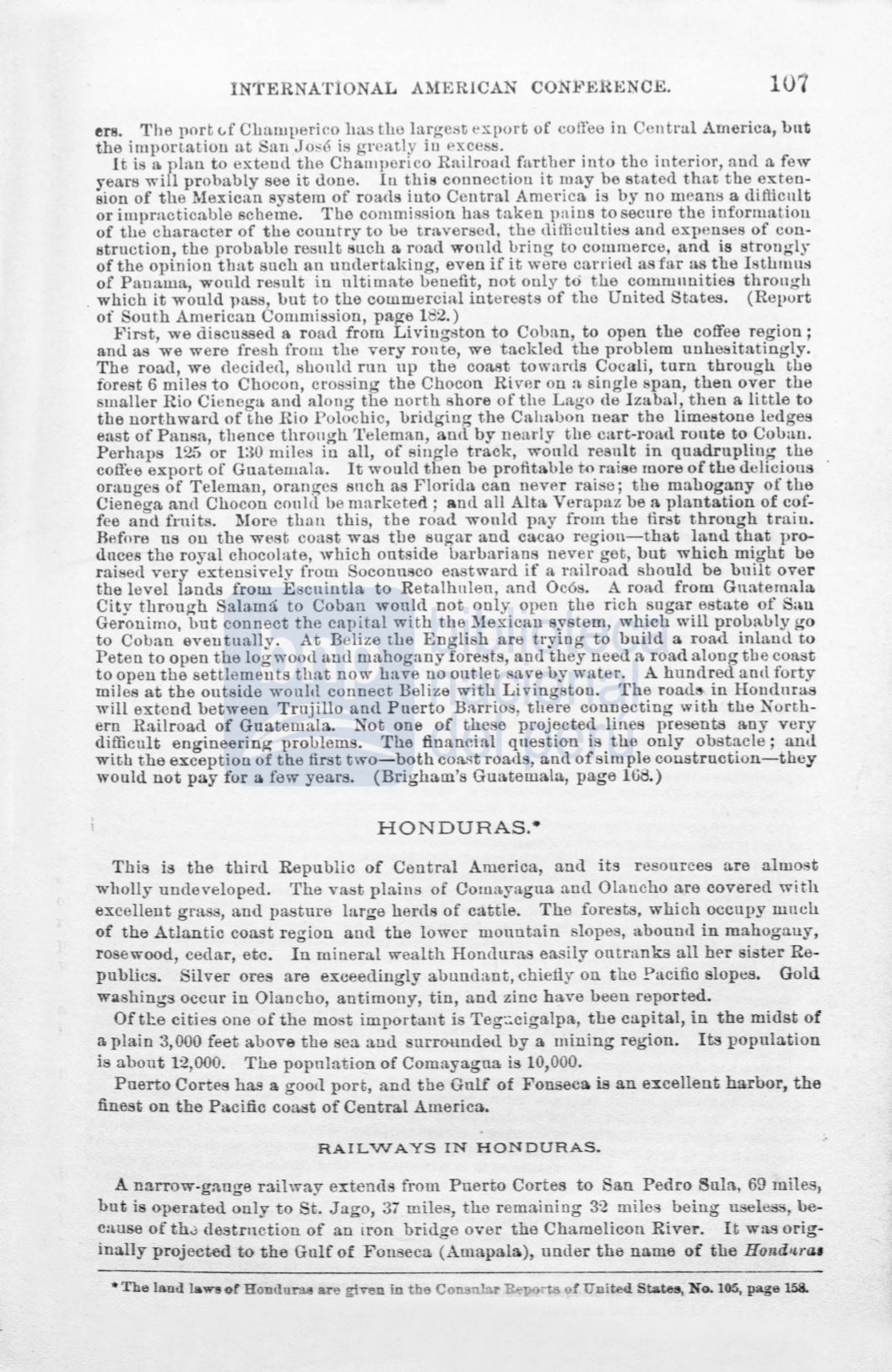

1NTERNAT10NAL AMERICAN CON.l!,ERENCE.
107
era. The port <-f Charuperico has the largest export of coffee in Central Amcrica, bnt
the importation at San José is greatly io Pxcess.
lt
is a planto extend the Champerico Railroad fartber into the interior, anda few
years will probably see it done.
In this coonection it may be stated that the exten–
sion of the Mexican system of roads iuto Central America. is by no means a difficnlt
or impracticable acherne. The commission has t:.tken pains to secure the informatiou
of tlle character of tlle country to be traversed, the difficulties and expenses of con–
struction, the probable resnlt such a road wonld bring to commerce, and is strongly
of the opinion tbat such au undertaking, even if it were carriecl as far as the
Isthmu::~
of Panama, would result in nltimate benefit, not only to the comrunnities throngh
. which it would pass, uut to the commercial interests of the United States.
(Report
of South American Corumission, page
182.)
First, we discussed a road from Livingston to Coban, to open the coffee regiou ;
andas we were fresh from the very ron te, we tackled the problem unhesitatingly.
The road, we decided, shonld run np the coast towards Cocali, turn through the
íorest 6 miles to Chocon, crossing the Chocon River on a single span, then over the
srnaller Rio Cienega and along the north shore of the Lago de Izabal, then alittle to
the northward of the Río Polochic, bridging the Cahabon near tho limestone ledges
east of Pansa, tbence throngh Teleman, and by nearly the cart-1·oad ronte to Cobau.
Perhaps
125
or
130
miles in all, of single track, wonld resnlt in quadrupling the
cotfee export of Guatemala.
It
would then be profitable to raise more of the delicious
ora.nges of Teleman, orangcs snch as Florida can never raise; the mn.hogany of the
Cienega and Chocon conld be marketed ; and all Alta Verapaz be a pln.ntation of cof–
fee and fruits. More than this, the road wonld pay from the first throngh train.
Refore ns ou the west coast was the sugar and cacao region-that land that pro–
duces the royal chocohtte, which ontside llarllarians never get, but which might be
raised very extensively from Soconusco eastward if a ra.ilroad sbould be built over
the level land
a from Escnintla. to Retalhnlen, and Ocós. A road from Gna.temala
City throngh
Sala.máto Coban would not only open the rich sngar estate of San
Geronimo, but connect the capital with the Me:s:ican system, which will prollably go
to Coban eventually. At Belize tbe English are trying to build a road inland to
Peten to open the logwood and m<thogany forests, and they need a road along the coast
to opeu tbe settlemeuts tha.t now bave no ontlet save by water. A hundred and forty
miles at the outside woulll connect Belize with Livingston. The
road~
in Honduras
will extcnd between Trujillo and Puerto Barrios, there connecting with tlle North–
ern Railroad of Guatemala. Not one of these projected lines presents any very
difficult engineering prolllems. The financia! question is the only obstacle; aml
wi.tbthe exception of the first two- both coast roads, and ofsimple coustruction-
they
would not pay for a. few years.
(Brigharn's Gua.ternala, page
1G8.)
HONDURAS.•
This is the third Republic of Central America, and its resources are alrnost
wholly undeveloped. The vast plains of Comayagua and Olaucho are covered with
excellent grass, and pasture large herds of cattle. The forests, which occupy ruuch
of the Atlantic coast region and the lowcr mountain slopes, abouml in mahogauy,
rosewood, cedar, etc.
In mineral wealth Honduras easily ontranks all her ister Re–
publica. Silver ores are exceediugly abundrmt, chiefiy on the Pacific slopes. Gold
washiugs occur in Ola.ncho, antirnony, tiu, and zinc have been reported.
Of tl:e cities one of the most import.aut is Teg;.;.cigalpa, the capital, in the midst of
a plain
3,000
feet ahove the sea
a.ndsurroundetl by a min.ing region.
Its popula.tion
is about
12,000.
The popnlation of Comayagna. is
10,000.
Puerto Cortes has a gootl port, and the Gnlf of Fouseca
i.s
an excellent harbor, the
finest on the Paciñc coast of Central America.
RAILWAYS IN HONDURAS.
A narrow-gange railway exten<ls from Puerto Cortes to San Pedro Sula, 69 miles,
but is operated only to St. Jago, 37 miles, the r ema.ining 32 milo
being n eless, be–
cause of thd destrnction of an tron bridge over- the Chamelicon River.
It
was orig–
inally projected to the Gulf of Fouseca (Amapala), nnder the name of the
Hond,,ra•
I
United States, No. 105, page
158.
















